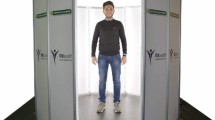Abstract
This article describes a software system for scanning and three-dimensional reconstruction of the human body using the two MS Kinect devices. The article describes the main stages of the conversion of partial frames of depth in the general polygon mesh model of the human body. Also, we propose and describe a method for constructing the surface in the “empty zones”. We show that using two Kinect devices our scanning system can reconstruct the human body and build the surface in “empty zones”. The main idea of our reconstructing approach is to divide the whole surface of human body in two parts: the front part and the back part. Each of that two parts is dividing in three parts with overlaps: the upper part (head, part of the chest, arms), middle part and lower part. Scans of each part aligned to each other with ICP algorithm and stored in two separate point clouds, which represents the front and back part of human body. Finally, two scans reconstructed and “empty zones” between them build with our algorithm based on Bezier curve model. In conclusion represent the final model of human bode with some parameters.
Access this chapter
Tax calculation will be finalised at checkout
Purchases are for personal use only
Similar content being viewed by others
References
Huang, X.Q., Adams, B., Wicke, M., Guibas, L.J.: Non-rigid registration under isometric deformations. Comput. Graph. Forum 27(5), 1449–1457 (2008)
Weiss, A., Hirshberg, D., Black, M.J.: Home 3D body scans from noisy image and range data. In: Proceedings of the IEEE International Conference on Computer Vision, pp. 1951–1958 (2011)
Newcombe, R.A., Izadi, S., Hilliges, O., Molyneaux, D., Kim, D., et al.: KinectFusion: real-time dense surface mapping and tracking. In: 2011 10th IEEE International Symposium on Mixed and Augmented Reality, ISMAR 2011 pp. 127–136 (2011)
Rozaliev, V.L., Orlova, Y.A.: Recognizing and analyzing emotional expressions in movements. In: Isaias, P. (ed.) E-Learning Systems, Environments and Approaches. Theory and Implementation, Part II, § 9, pp. 117–131. Springer (2015)
Shum, H.P.H., Ho, E.S.L., Jiang, Y., Takagi, S.: Real-time posture reconstruction for Microsoft Kinect. IEEE Trans. Cybern. 43(5), 1357–1369 (2013)
Li, H., Vouga, E., Gudym, A., Luo, L., Barron, J.T., et al.: 3D self-portraits. ACM Trans. Graph. 32(6) (2013)
Sanna, A., Lamberti, F., Paravati, G., Rocha, F.D.: A Kinect-based interface to animate virtual characters. J. Multimodal User Interfaces 7(4), 269–279 (2013)
Alekseev, A., Rozaliev, V., Orlova, Y.: Automatic coloring of grayscale images based on intelligent scene analysis. Pattern Recogn. Image Anal. (Advances in Mathematical Theory and Applications) 25(1), 10–21 (2015)
Kazhdan, M., Bolitho, M., Hoppe, H.: Poisson surface reconstruction. In: Eurographics Symposium on Geometry Processing, pp. 61–70 (2006)
Cui, Y., Chang, W., Nöll, T., Stricker, D.: KinectAvatar: fully automatic body capture using a single kinect. Lecture Notes in Computer Science (including subseries Lecture Notes in Artificial Intelligence and Lecture Notes in Bioinformatics), vol. 7729 LNCS (PART 2), pp. 133–147 (2013)
Lim, H., Lee, S.O., Lee, J.H., Sung, M.H., Cha, Y.W., et al.: Putting real-world objects into virtual world: fast automatic creation of animatable 3D models with a consumer depth camera. In: Proceedings—2012 International Symposium on Ubiquitous Virtual Reality, ISUVR 2012, pp. 38–41 (2012)
Chen, Y., Dang, G., Cheng, Z.Q., Xu, K.: Fast capture of personalized avatar using two Kinects. J. Manufact. Syst. 33(1), 233–240 (2014)
Acknowledgments
The study was financially supported by RFBR research projects №15-47-02149, 15-07-06322, 15-37-70014, 16-07-00407, 16-07-00453.
Author information
Authors and Affiliations
Corresponding author
Editor information
Editors and Affiliations
Rights and permissions
Copyright information
© 2016 Springer International Publishing Switzerland
About this paper
Cite this paper
Konstantinov, V.M., Rozaliev, V.L., Orlova, Y.A., Zaboleeva-Zotova, A.V. (2016). Development of 3D Human Body Model. In: Abraham, A., Kovalev, S., Tarassov, V., Snášel, V. (eds) Proceedings of the First International Scientific Conference “Intelligent Information Technologies for Industry” (IITI’16). Advances in Intelligent Systems and Computing, vol 451. Springer, Cham. https://doi.org/10.1007/978-3-319-33816-3_15
Download citation
DOI: https://doi.org/10.1007/978-3-319-33816-3_15
Published:
Publisher Name: Springer, Cham
Print ISBN: 978-3-319-33815-6
Online ISBN: 978-3-319-33816-3
eBook Packages: EngineeringEngineering (R0)




